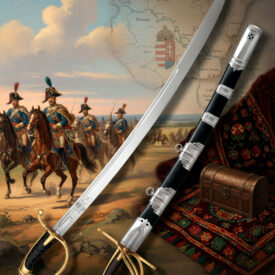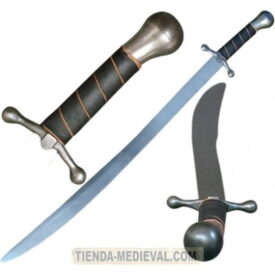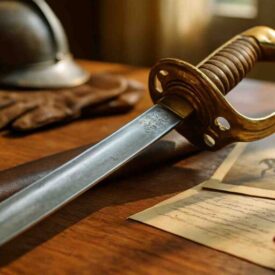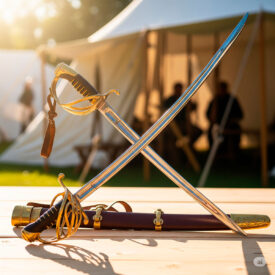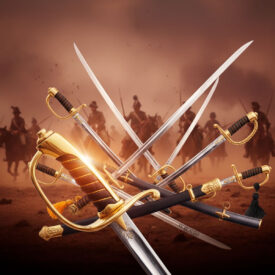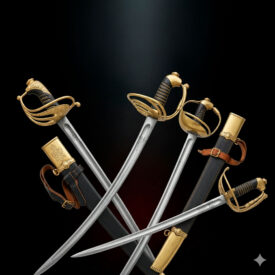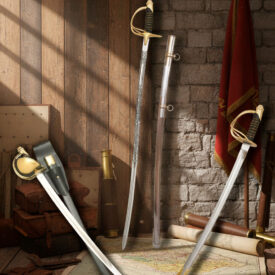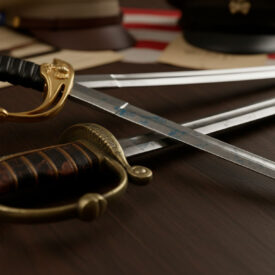What story lies hidden in the gleam of a saber in the parade sun? The Spanish Army saber is not merely an ornamental accessory: it is an emblem of authority, a piece of craftsmanship, and the silent witness of generations of officers who have sworn to defend the homeland.
In this article, you will discover how their models evolved, what differences exist between officers’ and non-commissioned officers’ sabers, what materials and artisanal processes are involved in their manufacture, and when and why they are used in modern ceremonies. I will guide you through timelines, comparative tables, and technical data that support current tradition and regulations.
Evolution of the saber in the Spanish Army: milestones and models
The history of the saber in the Spanish Army is articulated through successive regulations and models from the 19th century to the standardization of the mid-20th century, and continues today through technical specifications for ceremonial and educational use.
| Era | Event |
|---|---|
| 19th Century — Regulation and Models (1815–1891) | |
| 1815 | Artillery Corps officers carried the girdle sword as ordnance; the saber was used as a mounted weapon. Troops of mounted Artillery regiments used the saber models approved for light Cavalry. |
| 1833 | Ramón de Salas’s “Artillery Manual” mentions the blade of the Artillery Officer’s Sword, manufactured in Toledo, with a length of three feet. |
| 1850 | The work “Artillery, Steel and White Weapons” includes the design of the Artillery Officers’ girdle sword; it indicates that they used the Cavalry Officer’s saber, as the Cavalry had adopted a different model. |
| Late 1855 | A saber is adopted for the Mounted Artillery Brigade, constituting the first specific “Model” for Artillery; 480 copies were delivered to the Brigade. |
| 1856 (March 12) | The adoption of the 1855 model extends to “all mounted positions in the Corps.” |
| 1856 (Toledo Factory Tariff) | The tariff includes, in addition to the girdle sword, an “Artillery Officer’s saber” (111 reales) and a “Mounted Artillery Officer’s saber” (130 reales). |
| Between 1855 and 1861 | There were three main types of Artillery Officer’s sabers: “Officer” variants of the Md. 1855 saber; sabers with scimitar blades (with the referred model 1861 appearing in illustrated sources); and sabers with “sling saber” hilts. |
| 1862 (June 17) | The Artillery Officer’s saber, model 1862, a “sling saber” with the Corps emblem engraved on the guard, suitable for foot and mounted service, is approved. |
| 1878 | The manufacture of the 1862 model for mounted artillerymen is ordered to cease; it is replaced by the model 1860 saber of the light Cavalry. |
| 1891 | The Artillery Officer’s saber (Md. 1862) is modified by reducing the number of rings on the scabbard to one. |
| Republic and Standardization (1931–1943) | |
| 1931 (May 7 and June 27) | After the proclamation of the Republic, hilts bearing the royal crown or fleur-de-lis had to be replaced by the mural crown. |
| 1934 (July 2) | The traditional emblem of crossed cannons is replaced by the “bombeta” or flaming grenade, without a crown. The use of the Puerto-Seguro sword-saber variant for Artillery Officers with the crown removed or modified is also documented. |
| 1943 (January 27) | The Uniformity Regulations approve a single sword-saber model for Army Chiefs and Officers, ending specific Artillery Corps sabers. |
| Modern Regulation and Ceremonial Use (2019–2024) | |
| Ceremonial Use (Current) | The presentation of the saber to Cadets at the General Military Academy (usually in October) symbolizes obtaining the title of Knight or Lady Cadet and the status of Officer. The saber is used in formations and parades with weapons, oath-taking before the Flag, command changes, and by students of educational centers. |
| General Regulations (DEF/2024) | The saber must have a straight “Puerto Seguro” type blade of polished steel, according to the latest general regulations. |
| 2019 (before September 15) | Technical specifications for the Non-Commissioned Officer’s Saber with scabbard (Basic General Academy of Non-Commissioned Officers, AGBS): order for 500 units. Specifications: total length 940 mm (including scabbard); polished and nickel-plated blade of 790 ± 5 mm, completely straight; smooth nickel-plated hilt with the Army emblem (St. James’ Cross enameled in red) on the guard. |
| 2020 (before October 16) | Technical specifications for the Officer’s Saber with scabbard (General Military Academy, AGM): requested delivery of 450 sabers (400 for Army students and 50 for Common Corps). Specifications: handguard with the Army shield in high relief (eagle with St. James’ Cross enameled in red) and 24-carat gold plating; completely straight stainless steel blade (type 1.4034) with a length of 820 ± 5 mm; total weight 1,200 g (± 5%). |
Design, materials, and artisanal processes
 A military saber combines aesthetics and functionality. The blade, usually of polished stainless steel, seeks a balance between flexibility and resistance. The hilt and handguard are designed according to rank: nickel-plated for non-commissioned officers, often gold-plated for officers.
A military saber combines aesthetics and functionality. The blade, usually of polished stainless steel, seeks a balance between flexibility and resistance. The hilt and handguard are designed according to rank: nickel-plated for non-commissioned officers, often gold-plated for officers.
The processes are a mix of Toledo tradition and modern controls: steel selection, forging, tempering, polishing, and acid etching. Each stage demands precision so that the piece complies with technical standards and has the required ceremonial character.
Official models and technical specifications
Military academies receive sabers with precise specifications. Broadly speaking, the specifications differentiate the Officer’s saber and the Non-commissioned Officer’s saber in terms of dimensions, finishes, and ornaments, maintaining the uniform design required by the Army.
| Element | Officer’s Saber (AGM) | Non-commissioned Officer’s Saber (AGBS) |
|---|---|---|
| Total length | 96 cm (approx.) | 94 cm (with scabbard) |
| Blade | Stainless steel 1.4034, straight, 820 ± 5 mm | Polished nickel-plated steel, 790 ± 5 mm |
| Hilt | Nickel-plated brass with 24-carat gold plating; pommel with lion’s head | Nickel-plated, black plastic or wooden grips depending on model |
| Scabbard | Nickel-plated and chrome-plated carbon steel, 835 ± 5 mm | Nickel-plated steel, 815 ± 5 mm |
| Total weight | ~1,200 g | Saber 710 g; scabbard variable depending on chape |
- Officer’s Saber (AGM)
-
- Blade: 820 ± 5 mm, stainless steel type 1.4034.
- Handguard: brass with 24-carat gold plating and Army shield in high relief.
- Approximate weight: 1,200 g (saber + scabbard).
- Non-commissioned Officer’s Saber (AGBS)
-
- Blade: 790 ± 5 mm, nickel-plated.
- Hilt: smooth nickel-plated, black plastic or wooden grips according to specification.
- Usage: AGBS students in formations and parades.
Ceremonial use and symbolic meaning
In parades and protocol acts, the saber expresses command, honor, and commitment. The Saber Presentation Ceremony at the General Military Academy is a ritual charged with symbols: the veteran hands the blade to the novice, the Cadet’s Decalogue is invoked, and the new Knight or Lady Cadet is presented before the Virgin of Pilar.
Every element of the saber has a background: the guard speaks of justice, the hilt of truth, and the blade of duty. Together, they form an emblem that synthesizes tradition and responsibility.
Replicas and available models
Maintenance and conservation of a ceremonial piece
Maintaining a saber in optimal condition involves periodic cleaning, blade protection, and avoiding moisture in the scabbard. Mineral or camellia oils and greases for prolonged storage are common solutions; the goal is to preserve shine and prevent corrosion without modifying decorative finishes.
| Type | Properties | Recommendation |
|---|---|---|
| Mineral oil | Penetrates well and does not attract dirt | Regular blade protection |
| Camellia oil | Natural, stable, acid-free | Antioxidant protection and lubrication |
| Lithium grease | Dense and durable | Long-term storage |
Historical models and their tactical relevance
During the 19th and early 20th centuries, sabers had variants for cavalry, mounted artillery, and officers. Some models sought length for thrusting from horseback; others, such as “Puerto-Seguro” type blades, were adapted for marching and foot service.
Resolve your doubts about Spanish Army sabers
What is the history behind the design of Spanish Army sabers?
 The design of Spanish Army sabers has a history dating back to the 18th and early 19th centuries, when edged weapons were clearly differentiated by troop type: the straight sword for dragoons and the curved blade or saber for light cavalry, with characteristics adapted for rapid maneuvers and precise cuts. These sabers, forged with traditional artisanal techniques and high-quality steels to combine hardness and flexibility, became functional weapons and symbols of honor and rank within the army.
The design of Spanish Army sabers has a history dating back to the 18th and early 19th centuries, when edged weapons were clearly differentiated by troop type: the straight sword for dragoons and the curved blade or saber for light cavalry, with characteristics adapted for rapid maneuvers and precise cuts. These sabers, forged with traditional artisanal techniques and high-quality steels to combine hardness and flexibility, became functional weapons and symbols of honor and rank within the army.
In particular, the Spanish saber was widely used during the War of Independence (1808-1814) and the Napoleonic Wars, standing out for its versatile design which allowed for quick mounted actions and forceful wounds. Careful craftsmanship includes decorative details and hilts that reflect rank and unit, such as gilded adornments for officers, underscoring its importance not only practical but ceremonial and symbolic.
The current official saber of the Spanish Army continues this tradition, crafted with polished stainless steel, symbolic engravings, and nickel-plated brass hilts that evoke the historical legacy and respect for the Spanish military institution.
In summary, Spanish Army sabers are the result of a historical evolution that integrates military functionality, traditional craftsmanship, and symbolism, reflecting both the combat spirit and the prestige conferred upon their bearers.
What specific materials are used in the manufacture of Spanish Army sabers?
Spanish Army sabers are mainly manufactured with polished stainless steel blades, which provide strength and durability, and feature decorative acid-etched engravings. The hilt is made of nickel-plated brass for strength and a sophisticated finish, and in some non-commissioned officer models, the hilt can be made of dark wood with a nickel-plated or gilded pommel and guard. These materials combine tradition, functionality, and aesthetics adapted to the wearer’s rank.
How do officers’ sabers differ from those of enlisted soldiers in the Spanish Army?
 Officers’ sabers and enlisted soldiers’ sabers in the Spanish Army differ primarily in their design, materials, and ceremonial use. Here are some key differences:
Officers’ sabers and enlisted soldiers’ sabers in the Spanish Army differ primarily in their design, materials, and ceremonial use. Here are some key differences:
- Materials and ornamentation: Officers’ sabers typically use nobler materials such as ivory or mother-of-pearl, and are decorated with ornamental details such as engravings and metallic embellishments, which reflect the officers’ status and distinction. In contrast, enlisted soldiers’ sabers are more functional and less ornate.
- Purpose and design: Officers’ sabers can be lighter and are designed for both combat and ceremonial use, while soldiers’ sabers are optimized for effective combat on the battlefield.
- Ceremonial use: Officers’ sabers are frequently used in official events and ceremonies, where symbolic and aesthetic value is more important than martial functionality. On the other hand, enlisted soldiers’ sabers focus more on their effectiveness during battles.
In summary, although both types of sabers share the purpose of being combat weapons, officers’ sabers stand out for their ornamentation and ceremonial use, while enlisted soldiers’ sabers focus on functionality and effectiveness in combat.
What artisanal processes are used in the manufacture of Spanish Army sabers?
In the manufacture of Spanish Army sabers, artisanal processes combining tradition and technical precision are employed:
- Steel selection and forging: Special steels are used, selected to guarantee durability and resistance. The steel is forged and tempered using traditional techniques to achieve the proper balance between hardness and flexibility.
- Blade shaping: The blade is hand-molded, ensuring an effective edge and a robust profile, essential characteristics for military use.
- Finishing and engraving: After forging, artisanal finishes such as polishing and acid etching are performed, which may include personalized inscriptions according to rank or unit.
- Manufacture of the hilt and guard: Hilts and guards are crafted artisanally, using quality materials and applying decorative details that vary according to the officer’s rank, from simple designs for non-commissioned officers to more elaborate and gilded adornments for senior officers.
- Final assembly: All parts are manually assembled, ensuring both the functionality and aesthetics of the saber, respecting quality standards and military tradition.
These processes, heirs of Toledo craftsmanship, guarantee that each saber is an object of prestige, functionality, and symbolism within the Spanish Army.
What symbolism do sabers hold in military ceremonies and parades in Spain?
Sabers in military ceremonies and parades in Spain symbolize command, authority, honor, and officership. They represent a link to military tradition, being an emblem that officers receive as a distinction and a promise to embrace values such as courage, loyalty, and the duty to defend order. Each element of the saber has a meaning: the hilt symbolizes truth, the guard justice and peace, and the blade duty and the legitimacy of the use of force. In these acts, the saber is not only a complement to the uniform, but a tangible representation of the history, sacrifice, and military commitment.
| Type of oil | Main characteristics | Recommended use |
|---|---|---|
| Mineral oil | High penetration, does not degrade or attract dirt | Regular blade protection |
| Camellia oil | Natural, acid-free, non-volatile | Antioxidant protection and lubrication |
| Lithium grease | Dense, durable, does not evaporate | Long-term storage, protection |
Today, the saber remains a piece that unites past and present: a blade forged with modern technical criteria and a historical aura that recalls the responsibility of carrying a symbol of command. If you seek to understand its symbolic weight or its specifications, you now have the keys to value every detail.
VIEW SPANISH ARMY SABERS | VIEW MORE SPANISH SABERS | VIEW MORE MILITARY SABERS

